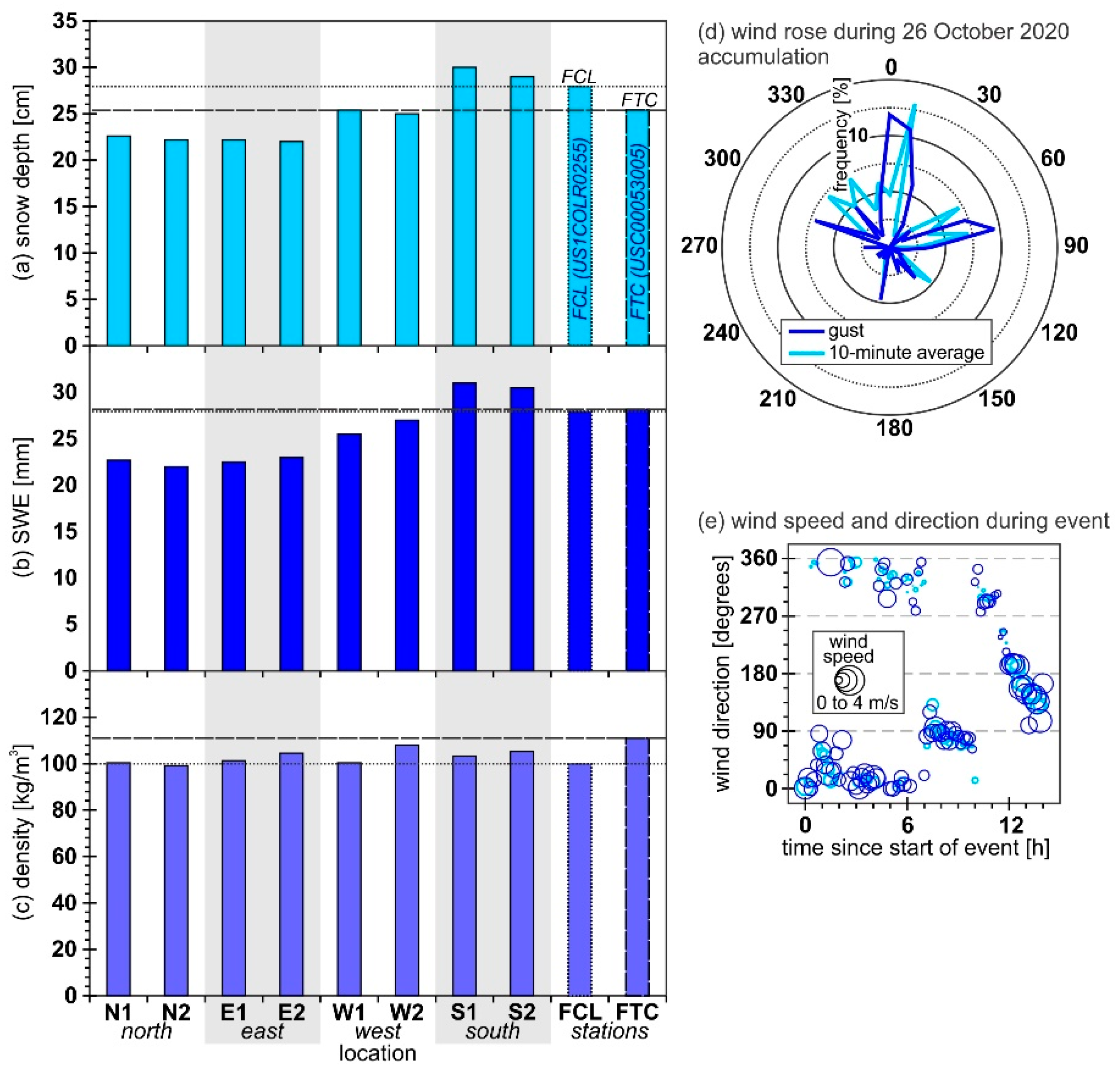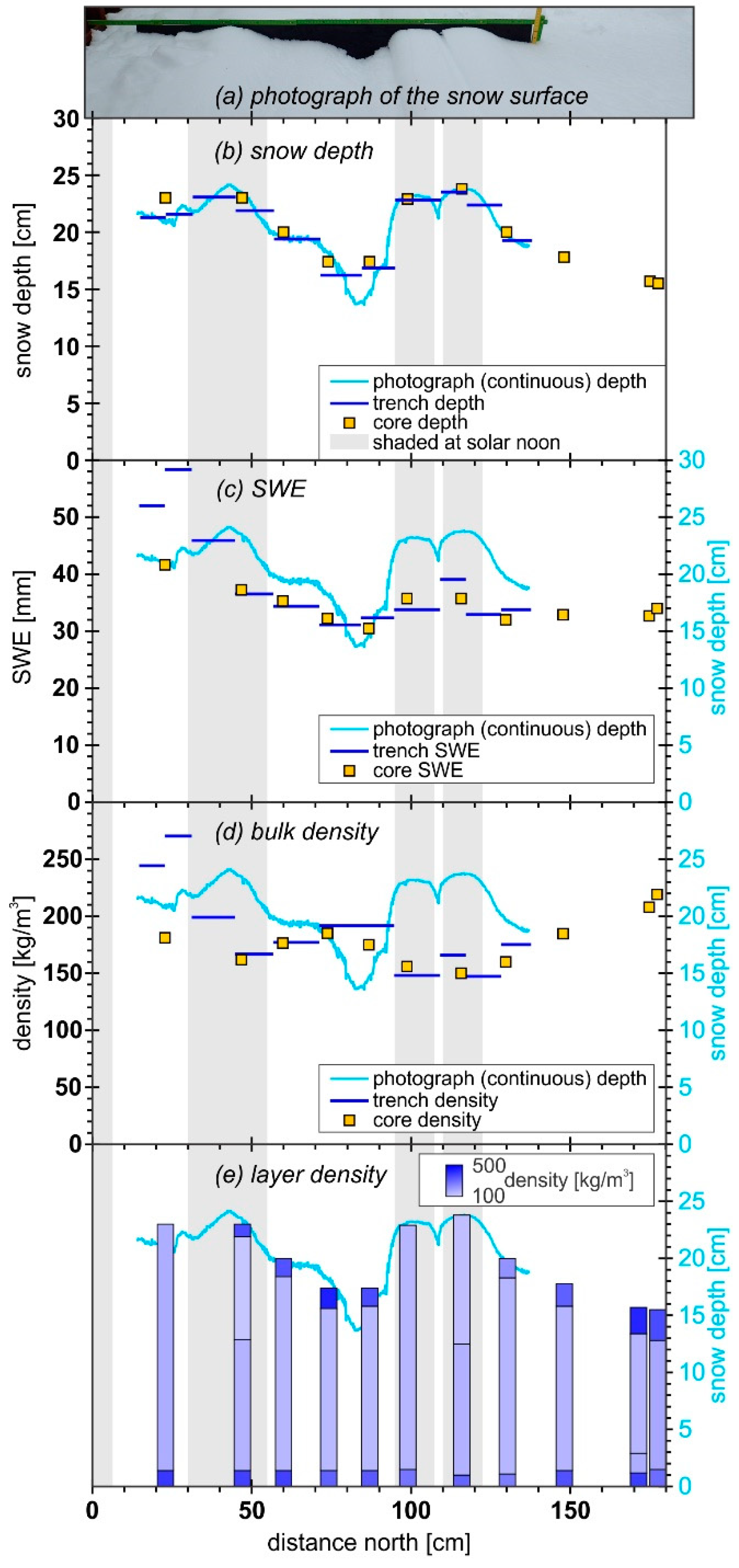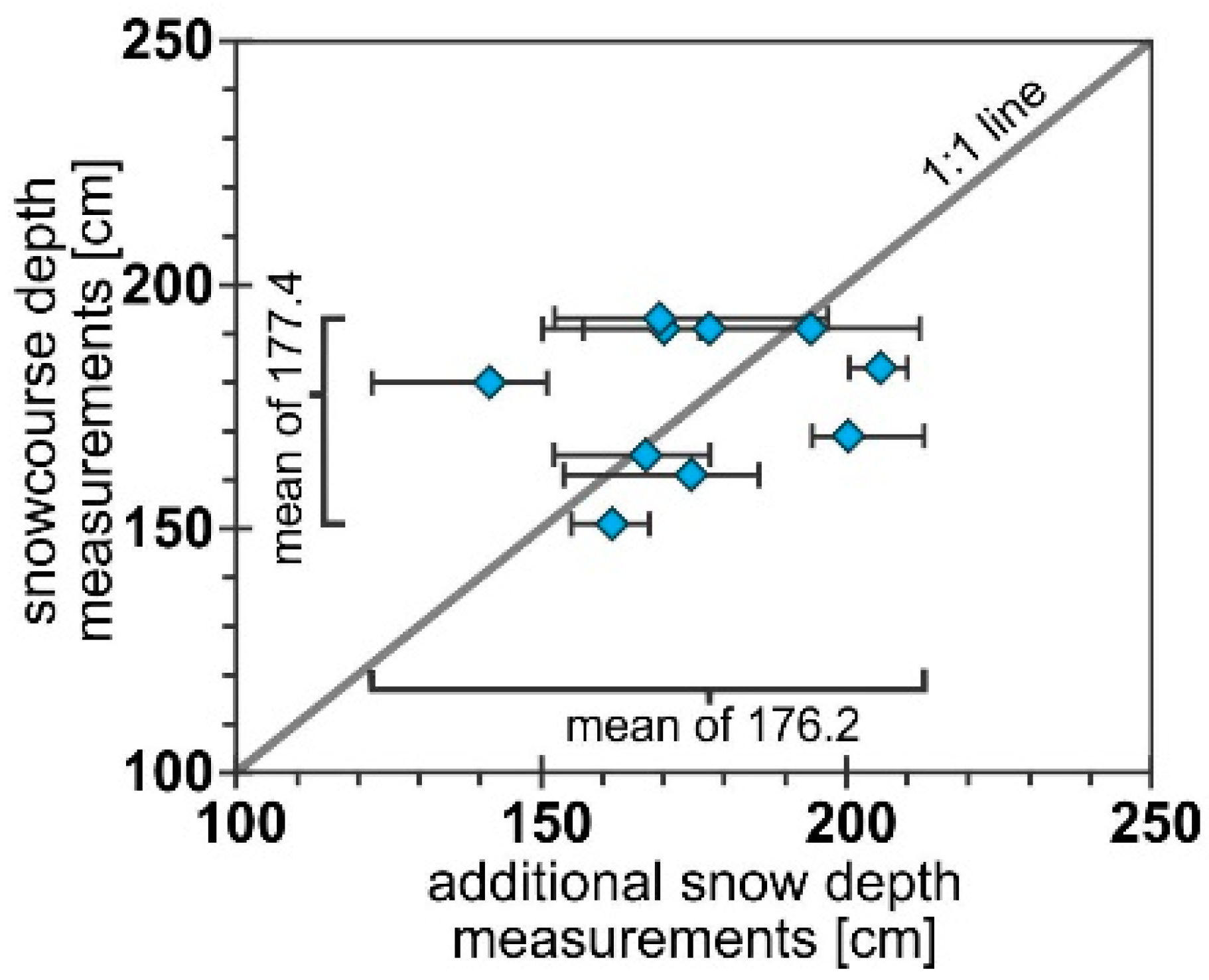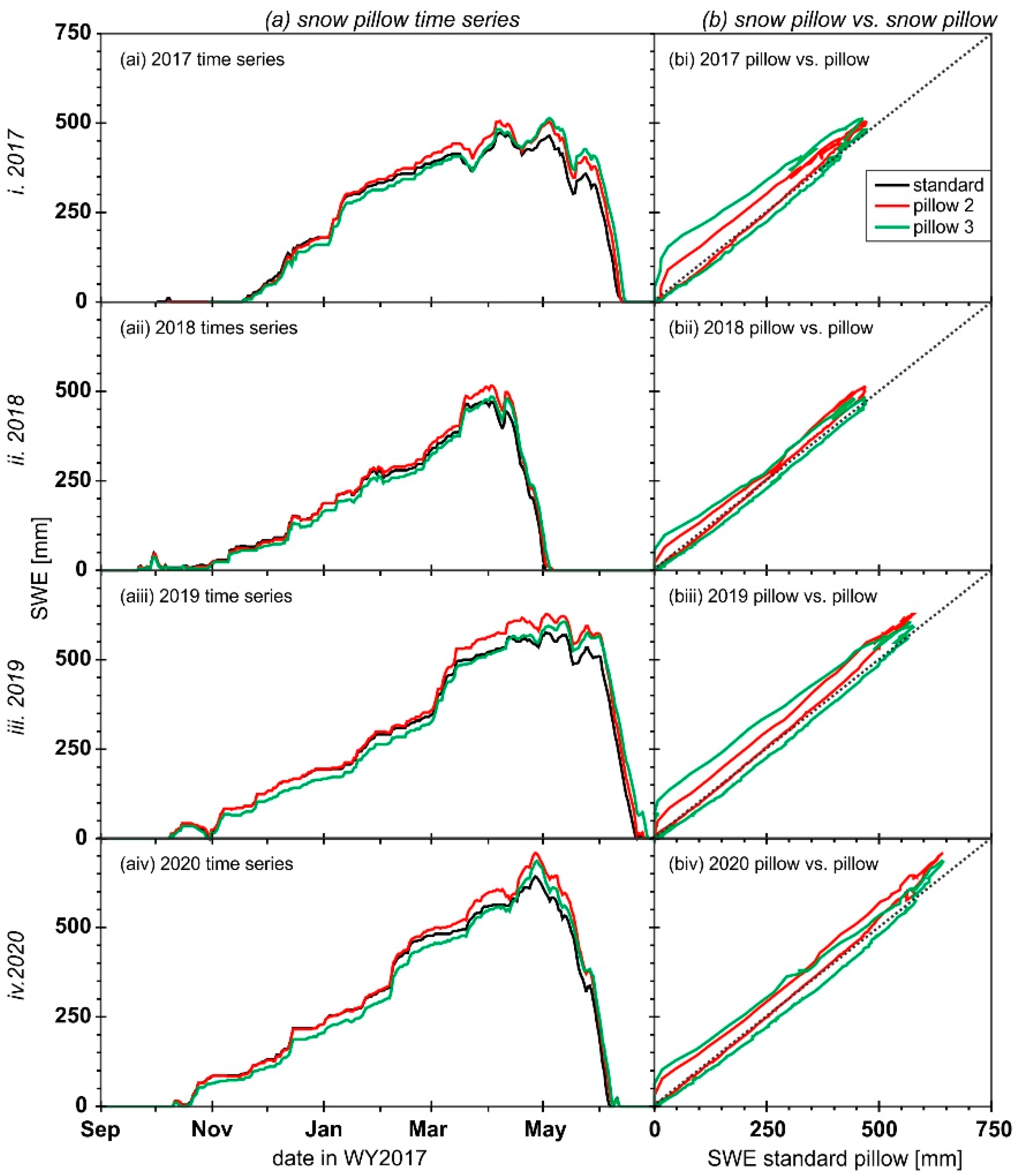A Call for More Snow Sampling
Abstract
:1. Introduction—Estimating the Amount of Snow in the Pack
2. Sampling and Analysis Methods
2.1. Measurement Evaluations
2.2. Airborne LiDAR Snow Depth
Data Used to Compare LiDAR Versus Probe Snow Depth Measurements
2.3. Snow Depth Probe Measurements
2.4. Fresh and Shallow Snow Depth, SWE and Density Measurements
Local-Scale Accumulation and Melt Measurements

2.5. Operational Measurement
3. Sampling Examples
3.1. Airborne LiDAR versus Snow Depth Probe Data
3.2. Fine Resolution Accumulation Differences
3.3. Fine Resolution Snowmelt Differences
3.4. Additional Snow Depth Measurements around Operational Stations
3.5. Sensor Comparisons
4. Discussion and Recommendations for Sampling
Supplementary Materials
Funding
Institutional Review Board Statement
Informed Consent Statement
Data Availability Statement
Acknowledgments
Conflicts of Interest
References
- Church, J.E. Recent studies of snow in the United States. Q. J. R. Meteorol. Soc. 1914, 40, 43–52. [Google Scholar] [CrossRef]
- Sproles, E.A.; Kerr, T.; Orrego Nelson, C.; Lopez Aspe, D. Developing a Snowmelt Forecast Model in the Absence of Field Data. Water Resour. Manag. 2016, 30, 2581–2590. [Google Scholar] [CrossRef]
- Gichamo, T.Z.; Tarboton, D.G. Ensemble streamflow forecasting using an energy balance snowmelt model coupled to a distributed hydrologic model with assimilation of snow and streamflow observations. Water Resour. Res. 2019, 55, 10813–10838. [Google Scholar] [CrossRef]
- Agnihotri, J.; Coulibaly, P. Evaluation of Snowmelt Estimation Techniques for Enhanced Spring Peak Flow Prediction. Water 2020, 12, 1290. [Google Scholar] [CrossRef]
- Rumsey, C.A.; Miller, M.P.; Sexstone, G.A. Relating hydroclimatic change to streamflow, baseflow, and hydrologic partitioning in the Upper Rio Grande Basin, 1980 to 2015. J. Hydrol. 2020, 584, 124715. [Google Scholar] [CrossRef]
- Armstrong, R.L.; Brun, E. (Eds.) Snow and Climate: Physical Processes, Surface Energy Exchange and Modeling; Cambridge University Press: Cambridge, UK, 2008; 222p. [Google Scholar]
- Räisänen, J. Warmer climate: Less or more snow? Clim. Dyn. 2008, 30, 307–319. [Google Scholar] [CrossRef]
- Laybourn-Parry, J.; Tranter, M.; Hodson, A.J. The Ecology of Snow and Ice Environments; Oxford University Press: Oxford, UK, 2012; 192p, ISBN 978-0-19-958308-9. [Google Scholar]
- Boelman, N.T.; Liston, G.E.; Gurarie, E.; Meddens, A.J.; Mahoney, P.J.; Kirchner, P.B.; Bohrer, G.; Brinkman, T.J.; Cosgrove, C.L.; Eitel, J.U.; et al. Integrating snow science and wildlife ecology in Arctic-boreal North America. Environ. Res. Lett. 2019, 14, 010401. [Google Scholar] [CrossRef]
- Sturm, M.; Goldstein, M.A.; Parr, C. Water and life from snow: A trillion dollar science question. Water Resour. Res. 2017, 53, 3534–3544. [Google Scholar] [CrossRef]
- Dozier, J.; Bair, E.H.; Davis, R.E. Estimating the spatial distribution of snow water equivalent in the world’s mountains. WIREs Water 2016, 3, 461–474. [Google Scholar] [CrossRef]
- Sturm, M. White water: Fifty years of snow research in WRR and the outlook for the future. Water Resour. Res. 2015, 51, 4948–4965. [Google Scholar] [CrossRef]
- Clark, M.P.; Hendrikx, J.; Slater, A.G.; Kavetski, D.; Anderson, B.; Cullen, N.J.; Kerr, T.; Hreinsson, E.O.; Woods, R.A. Representing spatial variability of snow water equivalent in hydrologic and land-surface models: A review. Water Resour. Res. 2011, 47, W07539. [Google Scholar] [CrossRef] [Green Version]
- Blöschl, G. Scaling issues in snow hydrology. Hydrol. Process. 1999, 13, 2149–2175. [Google Scholar] [CrossRef]
- Leavesley, G.H.; Lichty, R.W.; Troutman, B.M.; Saindon, L.G. Precipitation-Runoff Modeling System: User’s Manual; U.S. Geological Survey Water-Resources Investigations Report 83-4238; U.S. Geological Survey: Reston, VA, USA, 1983; 207p.
- Markstrom, S.L.; Regan, R.S.; Hay, L.E.; Viger, R.J.; Webb, R.M.T.; Payn, R.A.; LaFontaine, J.H. PRMS-IV, the Precipitation-Runoff Modeling System, Version 4; U.S. Geological Survey Techniques and Methods, Book 6, Chapter B7; U.S. Geological Survey: Reston, VA, USA, 2015; 158p.
- Liang, X.; Lettenmaier, D.P.; Wood, E.F.; Burges, S.J. A simple hydrologically based model of land surface water and energy fluxes for general circulation models. J. Geophys. Res. 1994, 99, 14415–14428. [Google Scholar] [CrossRef]
- Hamman, J.J.; Nijssen, B.; Bohn, T.J.; Gergel, D.R.; Mao, Y. The Variable Infiltration Capacity model version 5 (VIC-5): Infrastructure improvements for new applications and reproducibility. Geosci. Model Dev. 2018, 11, 3481–3496. [Google Scholar] [CrossRef] [Green Version]
- Hall, D.K.; Riggs, G.A.; Salomonson, V.V.; DiGirolamo, N.E.; Bayr, J.J. MODIS snow-cover products. Remote Sens. Environ. 2002, 83, 181–194. [Google Scholar] [CrossRef] [Green Version]
- Tran, H.; Nguyen, P.; Ombadi, M.; Hsu, K.L.; Sorooshian, S.; Qing, X. A cloud-free MODIS snow cover dataset for the contiguous United States from 2000 to 2017. Sci. Data 2019, 6, 180300. [Google Scholar] [CrossRef] [PubMed]
- Chang, A.T.C.; Foster, J.L.; Hall, D.K. Nimbus-7 SMMR derived global snow cover parameters. Ann. Glaciol. 1987, 9, 39–44. [Google Scholar] [CrossRef] [Green Version]
- Gonzalez, R.; Kummerow, C.D. AMSR-E Snow: Can Snowfall Help Improve SWE Estimates? J. Hydrometeorol. 2020, 21, 2551–2564. [Google Scholar] [CrossRef]
- López-Moreno, J.I.; Fassnacht, S.R.; Heath, J.T.; Musselman, K.; Revuelto, J.; Latron, J.; Morán, E.; Jonas, T. Spatial variability of snow density over complex alpine terrain: Implications for estimating snow water equivalent. Adv. Water Resour. 2013, 55, 40–52. [Google Scholar] [CrossRef] [Green Version]
- López-Moreno, J.I.; Leppänen, L.; Luks, B.; Holko, L.; Picard, G.; Sanmiguel-Vallelado, A.; Alonso-González, E.; Finger, D.C.; Arslan, A.N.; Gillemot, K.; et al. Intercomparison of measurements of bulk snow density and water equivalent of snow cover with snow core samplers: Instrumental bias and variability induced by observers. Hydrol. Process. 2020, 34, 3120–3133. [Google Scholar] [CrossRef]
- López-Moreno, J.I.; Fassnacht, S.R.; Beguería, S.; Latron, J.B.P. Variability of snow depth at the plot scale: Implications for mean depth estimation and sampling strategies. Cryosphere 2011, 5, 617–629. [Google Scholar] [CrossRef] [Green Version]
- Meromy, L.; Molotch, N.P.; Link, T.E.; Fassnacht, S.R.; Rice, R. Subgrid variability of snow water equivalent at operational snow stations in the western United States. Hydrol. Process. 2013, 27, 2383–2400. [Google Scholar] [CrossRef]
- Fassnacht, S.R.; Brown, K.S.; Blumberg, E.J.; López Moreno, J.I.; Covino, T.P.; Kappas, M.; Huang, Y.; Leone, V.; Kashipazha, A.H. Distribution of Snow Depth Variability. Front. Earth Sci. 2018, 12, 683–692. [Google Scholar] [CrossRef]
- Sturm, M.; Holmgren, J. An automatic snow depth probe for field validation campaigns. Water Resour. Res. 2018, 54, 9695–9701. [Google Scholar] [CrossRef]
- Neppel, L.; Renard, B.; Lang, M.; Ayral, P.-A.; Coeur, D.; Gaume, E.; Jacob, N.; Payrastre, O.; Pobanz, K.; Vinet, F. Flood frequency analysis using historical data: Accounting for random and systematic errors. Hydrol. Sci. J. 2010, 55, 192–208. [Google Scholar] [CrossRef]
- Hastings, W.K. Monte Carlo sampling methods using Markov chains and their applications. Biometrika 1970, 57, 97–109. [Google Scholar] [CrossRef]
- Hultstrand, D.M.; Fassnacht, S.R. The Sensitivity of Snowpack Sublimation Estimates to Instrument and Measurement Uncertainty Perturbed in a Monte Carlo Framework. Front. Earth Sci. 2018, 12, 728–738. [Google Scholar] [CrossRef]
- Isaaks, E.H.; Srivastava, R.M. Spatial continuity measures for probabilistic and deterministic geostatistics. Math. Geol. 1988, 20, 313–341. [Google Scholar] [CrossRef]
- Shook, K.; Gray, D.M. Small-scale spatial structure of shallow snowcovers. Hydrol. Process. 1996, 10, 1283–1292. [Google Scholar] [CrossRef]
- Deems, J.S.; Fassnacht, S.R.; Elder, K.J. Fractal distribution of snow depth from LiDAR data. J. Hydrometeorol. 2006, 7, 285–297. [Google Scholar] [CrossRef]
- Hopkinson, C.; Sitar, M.; Chasmer, L.; Gynan, C.; Agro, D.; Enter, R.; Foster, J.; Heels, N.; Hoffman, C.; Nillson, J.; et al. Mapping the spatial distribution of snowpack depth beneath a variable forest canopy using airborne laser altimetry. In Proceedings of the 58th Eastern Snow Conference, Ottawa, ON, Canada, 14–18 May 2001; pp. 253–264. [Google Scholar]
- Deems, J.S.; Painter, T.H.; Finnegan, D.C. Lidar measurement of snow depth: A review. J. Glaciol. 2013, 59, 467–479. [Google Scholar] [CrossRef] [Green Version]
- Revuelto, J.; López Moreno, J.I.; Azorín Molina, C.; Vicente Serrano, S.M.; Serreta, A. Aplicación de la tecnología láser escáner terrestre georreferenciada para la monitorización del manto de nieve y los glaciares. In Proceedings of the VIII Congreso de la Asociación Española de Climatología, Salamanca, Spain, 25–28 September 2012; Publicaciones de la Asociación Española de Climatología. Serie A. pp. 929–939. [Google Scholar]
- Painter, T.H.; Berisford, D.F.; Boardman, J.W.; Bormann, K.J.; Deems, J.S.; Gehrke, F.; Hedrick, A.; Joyce, M.; Laidlaw, R.; Marks, D.; et al. The Airborne Snow Observatory: Fusion of scanning lidar, imaging spectrometer, and physically-based modeling for mapping snow water equivalent and snow albedo. Remote Sens. Environ. 2016, 184, 139–152. [Google Scholar] [CrossRef] [Green Version]
- Schutz, B.E.; Zwally, H.J.; Shuman, C.A.; Hancock, D.; DiMarzio, J.P. Overview of the ICESat Mission. Geophys. Res. Lett. 2005, 32, L21S01. [Google Scholar] [CrossRef] [Green Version]
- Abdalati, W.; Zwally, H.J.; Bindschadler, R.; Csatho, B.; Farrell, S.L.; Fricker, H.A.; Harding, D.; Kwok, R.; Lefsky, M.; Markus, T.; et al. The ICESat-2 Laser Altimetry Mission. Proc. IEEE 2010, 98, 735–751. [Google Scholar] [CrossRef]
- Cline, D.; Yueh, S.; Chapman, B.; Stankov, B.; Gasiewski, A.; Masters, D.; Elder, K.; Kelly, R.; Painter, T.H.; Miller, S.; et al. NASA Cold Land Processes Experiment (CLPX 2002/03): Airborne Remote Sensing. J. Hydrometeorol. 2009, 10, 338–346. [Google Scholar] [CrossRef]
- Trujillo, E.; Ramirez, J.A.; Elder, K.J. Topographic, meteorologic, and canopy controls on the scaling characteristics of the spatial distribution of snow depth fields. Water Resour. Res. 2007, 43, W07409. [Google Scholar] [CrossRef]
- McCreight, J.L.; Slater, A.G.; Marshall, H.P.; Rajagopalan, B. Inference and uncertainty of snow depth spatial distribution at the kilometre scale in the Colorado Rocky Mountains: The effects of sample size, random sampling, predictor quality, and validation procedures. Hydrol. Process. 2014, 28, 933–957. [Google Scholar] [CrossRef]
- Currier, W.R.; Pflug, J.; Mazzotti, G.; Jonas, T.; Deems, J.S.; Bormann, K.J.; Painter, T.H.; Hiemstra, C.A.; Gelvin, A.; Uhlmann, Z.; et al. Comparing aerial lidar observations with terrestrial lidar and snow-probe transects from NASA’s 2017 SnowEx campaign. Water Resour. Res. 2019, 55, 6285–6294. [Google Scholar] [CrossRef] [Green Version]
- Tedesche, M.E.; Fassnacht, S.R.; Meiman, P.J. Scales of Snow Depth Variability in High Elevation Rangeland Sagebrush. Front. Earth Sci. 2017, 11, 469–481. [Google Scholar] [CrossRef]
- Elder, K.; Cline, D.; Liston, G.E.; Armstrong, R. NASA Cold Land Processes Experiment (CLPX 2002/03): Field Measurements of Snowpack Properties and Soil Moisture. J. Hydrometeorol. 2009, 10, 320–329. [Google Scholar] [CrossRef] [Green Version]
- Farnes, P.F.; Goodison, B.E.; Peterson, N.R.; Richards, R.P. Metrication of Manual Snow Sampling Equipment. In Proceedings of the Final Report Western Snow Conference, Spokane, WA, USA, 19–21 April 1983. [Google Scholar]
- Dixon, D.; Boon, S. Comparison of the SnowHydro snow sampler with existing snow tube designs. Hydrol. Process. 2012, 26, 2555–2562. [Google Scholar] [CrossRef]
- Doesken, N.J.; Judson, A. The Snow Booklet. A Guide to the Science, Climatology and Measurement of Snow in the United States; Department of Atmospheric Sciences, Colorado State University: Fort Collins, CO, USA, 1996; 84p. [Google Scholar]
- Fassnacht, S.R.; Heun, C.M.; López-Moreno, J.I.; Latron, J.B.P. Variability of Snow Density Measurements in the Rio Esera Valley, Pyrenees Mountains, Spain. Cuad. Investig. Geográfica (Geogr. Res. Lett.) 2010, 36, 59–72. [Google Scholar] [CrossRef] [Green Version]
- US Army Corps. Snow Hydrology: Summary Report of the Snow Investigations; North Pacific Division, Corps of Engineers, U.S. Army: Portland, OR, USA, 1956; 437p.
- Rees, W.G. A rapid method of measuring snow surface profiles. J. Glaciol. 1998, 44, 674–675. [Google Scholar] [CrossRef] [Green Version]
- Fassnacht, S.R.; Stednick, J.D.; Deems, J.S.; Corrao, M.V. Metrics for assessing snow surface roughness from digital imagery. Water Resour. Res. 2009, 45, W00D31. [Google Scholar] [CrossRef]
- Burns, P.J.; (Chief Information Officer, Colorado State University System, Denver, CO, USA). Personal communication. 2012. [Google Scholar]
- U.S. Department of Agriculture. Snow Survey and Water Supply Forecasting. In National Engineering Handbook Part 622; National Water and Climate Center (USDA): Portland, OR, USA, 2011. [Google Scholar]
- Ryan, W.A.; Doesken, N.J.; Fassnacht, S.R. Preliminary results of ultrasonic snow depth sensor testing for National Weather Service (NWS) snow measurements in the US. Hydrol. Process. 2008, 22, 2748–2757. [Google Scholar] [CrossRef] [Green Version]
- López-Moreno, J.I.; Alvera, B.; Latron, J.; Fassnacht, S.R. Instalación y Uso de un Colchón de Nieve para la Monitorización del Manto de Nieve, Cuenca Experimental de Izas (Pirineo Central). Cuad. Investig. Geográfica (Geogr. Res. Lett.) 2010, 36, 73–85. [Google Scholar] [CrossRef] [Green Version]
- National Water and Climate Center (USDA). Snow Survey and Water Supply Forecasting Program. Available online: https://www.wcc.nrcs.usda.gov/snotel/program_brochure.pdf (accessed on 13 April 2021).
- Beaumont, R.T. Mt. Hood Pressure Pillow Snow Gage. J. Appl. Meteorol. Climatol. 1965, 4, 626–631. [Google Scholar] [CrossRef] [Green Version]
- Johnson, J.B.; Marks, D. The detection and correction of snow water equivalent pressure sensor errors. Hydrol. Process. 2004, 18, 3513–3525. [Google Scholar] [CrossRef]
- Prokop, A.; Schirmer, M.; Rub, M.; Lehning, M.; Stocker, M. A comparison of measurement methods: Terrestrial laser scanning, tachymetry and snow probing, for the determination of spatial snow depth distribution on slopes. Ann. Glaciol. 2008, 49, 210–216. [Google Scholar] [CrossRef] [Green Version]
- Hood, J.L.; Hayashi, M. Assessing the application of a laser rangefinder for determining snow depth in inaccessible alpine terrain. Hydrol. Earth Syst. Sci. 2010, 14, 901–910. [Google Scholar] [CrossRef] [Green Version]
- Hiemstra, C.A.; (Geospatial Management Office, Geospatial Technology and Applications Center, U.S. Forest Service, Salt Lake City, UT, USA). Personal communication. 2012. [Google Scholar]
- Deems, J.S.; Fassnacht, S.R.; Elder, K.J. Interannual consistency in fractal snow depth patterns at two Colorado mountain sites. J. Hydrometeorol. 2008, 9, 977–988. [Google Scholar] [CrossRef]
- Erxleben, J.; Elder, K.; Davis, R. Comparison of spatial interpolation methods for estimating snow distribution in the Colorado Rocky Mountains. Hydrol. Process. 2002, 16, 3627–3649. [Google Scholar] [CrossRef]
- Fassnacht, S.R.; Deems, J.S. Measurement sampling and scaling for deep montane snow depth data. Hydrol. Process. 2006, 20, 829–838. [Google Scholar] [CrossRef]
- Meinhardt, M.; Fassnacht, S.R. Fresh Snow Density from the Fort Collins Colorado Meteorological Station and New Measurements. Colo. Water 2020, 37, 7–9. [Google Scholar] [CrossRef]
- Rice, R.; Bales, R.C. Embedded-sensor network design for snow cover measurements around snow pillow and snow course sites in the Sierra Nevada of California. Water Resour. Res. 2010, 46, W03537. [Google Scholar] [CrossRef]
- Fassnacht, S.R.; Hultstrand, M. Snowpack Variability and Trends at Long-term Stations in Northern Colorado, USA. Proc. Int. Assoc. Hydrol. Sci. 2015, 371, 131–136. [Google Scholar] [CrossRef] [Green Version]
- Domonkos, B.; (Snow Survey Supervisor, NRCS Colorado Snow Survey Office, Denver, CO, USA). Personal communication. 2016. [Google Scholar]
- Sexstone, G.A.; Clow, D.W.; Fassnacht, S.R.; Liston, G.E.; Hiemstra, C.A.; Knowles, J.F.; Penn, C.A. Snow sublimation in mountain environments and its sensitivity to forest disturbance and climate warming. Water Resour. Res. 2018, 54, 1191–1211. [Google Scholar] [CrossRef]
- Erickson, T.A.; Williams, M.W.; Winstral, A. Persistence of topographic controls on the spatial distribution of snow in rugged mountain terrain, Colorado, United States. Water Resour. Res. 2005, 41, W04014. [Google Scholar] [CrossRef] [Green Version]
- Egli, L.; Jonas, T. Hysteretic dynamics of seasonal snow depth distribution in the Swiss Alps. Geophys. Res. Lett. 2009, 36, L02501. [Google Scholar] [CrossRef] [Green Version]
- Schrock, I.J.Y.; Fassnacht, S.R.; Pfohl, A.K.D.; Collados-Lara, A.-J.; Sanford, W.E.; Morán-Tejeda, E. Snow Water Equivalent Accumulation Patterns from a Trajectory Approach over the U.S. Southern Rocky Mountains. Hydrology 2021, 8, 124. [Google Scholar] [CrossRef]
- Sturm, M.; Wagner, A.M. Using repeated patterns in snow distribution modeling: An Arctic example. Water Resour. Res. 2010, 46, W12549. [Google Scholar] [CrossRef] [Green Version]
- Hultstrand, D.M. Uncertainty in Hydrological Estimation. Ph.D. Thesis, Watershed Science, Colorado State University, Fort Collins, CO, USA, 2021. Unpublished. Available online: http://hdl.handle.net/10217/232572 (accessed on 30 July 2021).
- Fassnacht, S.R.; Venable, N.B.H.; McGrath, D.; Patterson, G.G. Sub-seasonal Snowpack Trends in the Rocky Mountain National Park Area, Colorado USA. Water 2018, 10, 562. [Google Scholar] [CrossRef] [Green Version]
- Fassnacht, S.R.; Patterson, G.G. Niveograph Interpolation to Estimate Peak Accumulation at Two Mountain Sites. In Cold and Mountain Region Hydrological Systems Under Climate Change: Towards Improved Projections, Proceedings of Symposium H02, IAHS-IAPSO-IASPEI Assembly, Gothenburg, Sweden, 22–26 July 2013; IAHS Press: Wallingford, UK, 2013; Volume 360, pp. 59–64. [Google Scholar]
- Liston, G.E.; Elder, K.A. Meteorological Distribution System for High-Resolution Terrestrial Modeling (MicroMet). J. Hydrometeorol. 2006, 7, 217–234. [Google Scholar] [CrossRef] [Green Version]
- Elder, K.; Dozier, J.; Michaelsen, J. Snow accumulation and distribution in an alpine watershed. Water Resour. Res. 1991, 27, 1541–1552. [Google Scholar] [CrossRef] [Green Version]
- Watson, F.G.R.; Anderson, T.N.; Newman, W.B.; Alexander, S.E.; Garott, R.A. Optimal sampling schemes for estimating snow water equivalents in stratified heterogeneous landscapes. J. Hydrol. 2006, 328, 432–452. [Google Scholar] [CrossRef]
- Kronholm, K.; Birkeland, K.W. Reliability of sampling designs for spatial snow surveys. Comput. Geosci. 2007, 33, 1097–1110. [Google Scholar] [CrossRef]
- Young, A.; Young, M.; Scott, B. Scale Break; J. Albert & Son Pty Ltd.: Sydney, Australia, 1976. [Google Scholar]
- Julander, R.P.; Curtis, J.; Beard, A. The SNOTEL temperature dataset. Mt. Views Newsl. 2007, 1, 4–7. Available online: http://www.fs.fed.us/psw/cirmount/ (accessed on 18 February 2020).
- Oyler, J.W.; Dobrowski, S.Z.; Ballantyne, A.P.; Klene, A.E.; Running, S.W. Artificial amplification of warming trends across the mountains of the western United States. Geophys. Res. Lett. 2015, 42, 153–161. [Google Scholar] [CrossRef] [Green Version]
- Ma, C.; Fassnacht, S.R.; Kampf, S.K. How temperature sensor change affects warming trends and modeling–An evaluation across the State of Colorado. Water Resour. Res. 2019, 55, 9748–9764. [Google Scholar] [CrossRef]
- Meiman, J.R. Snow accumulation related to elevation, aspect, and forest canopy. In Proceedings of the Snow Hydrology Workshop Seminar, Fredericton, NB, Canada, 28–29 February 1968; pp. 35–47. [Google Scholar]
- Wickham, J.; Homer, C.; Vogelmann, J.; McKerrow, A.; Mueller, R.; Herold, N.; Coulston, J. The Multi-Resolution Land Characteristics (MRLC) Consortium—20 Years of Development and Integration of USA National Land Cover Data. Remote Sens. 2014, 6, 7424–7441. [Google Scholar] [CrossRef] [Green Version]
- Lefsky, M.A.; Cohen, W.B.; Harding, D.J.; Parker, G.G.; Acker, S.A.; Gower, S.T. Lidar remote sensing of above-ground biomass in three biomes. Glob. Ecol. Biogeogr. 2002, 11, 393–399. [Google Scholar] [CrossRef] [Green Version]
- Fassnacht, S.R.; López-Moreno, J.I.; Ma, C.; Weber, A.N.; Pfohl, A.K.D.; Kampf, S.K.; Kappas, M. Spatio-temporal Snowmelt Variability across the Headwaters of the Southern Rocky Mountains. Front. Earth Sci. 2017, 11, 505–514. [Google Scholar] [CrossRef]
- Oroza, C.A.; Zheng, Z.; Glaser, S.D.; Tuia, D.; Bales, R.D. Optimizing embedded sensor network design for catchment-scale snow-depth estimation using LiDAR and machine learning. Water Resour. Res. 2016, 52, 8174–8189. [Google Scholar] [CrossRef] [Green Version]
- Nolan, M.; Larsen, C.; Sturm, M. Mapping snow depth from manned aircraft on landscape scales at centimeter resolution using structure-from-motion photogrammetry. Cryosphere 2015, 9, 1445–1463. [Google Scholar] [CrossRef] [Green Version]
- Fernandes, R.; Prevost, C.; Canisius, F.; Leblanc, S.G.; Maloley, M.; Oakes, S.; Holman, K.; Knudby, A. Monitoring snow depth change across a range of landscapes with ephemeral snowpacks using structure from motion applied to lightweight unmanned aerial vehicle videos. Cryosphere 2018, 12, 3535–3550. [Google Scholar] [CrossRef] [Green Version]
- Ellerbruch, D.A.; Boyne, H.S. Snow Stratigraphy and Water Equivalence Measured with an Active Microwave System. J. Glaciol. 1980, 26, 225–233. [Google Scholar] [CrossRef]
- Marshall, H.-P.; Koh, G.; Forster, R.R. Ground-based frequency-modulated continuous wave radar measurements in wet and dry snowpacks, Colorado, USA: An analysis and summary of the 2002–03 NASA CLPX data. Hydrol. Process. 2004, 18, 3609–3622. [Google Scholar] [CrossRef]
- McGrath, D.; Webb, R.; Shean, D.; Bonnell, R.; Marshall, H.P.; Painter, T.H.; Molotch, N.P.; Elder, K.; Hiemstra, C.; Brucker, L. Spatially extensive ground-penetrating radar snow depth observations during NASA’s 2017 SnowEx campaign: Comparison with in situ, airborne, and satellite observations. Water Resour. Res. 2019, 55, 10026–10036. [Google Scholar] [CrossRef] [Green Version]
- Bonnell, R.; McGrath, D.; Williams, K.; Webb, R.; Fassnacht, S.R.; Marshall, H.-P. Spatiotemporal Variations in Liquid Water Content in a Seasonal Snowpack: Implications for Radar Remote Sensing. Remote Sens. 2021, 13, 4223. [Google Scholar] [CrossRef]
- Larson, K.M.; Gutmann, E.D.; Zavorotny, V.U.; Braun, J.J.; Williams, M.W.; Nievinski, F.G. Can we measure snow depth with GPS receivers? Geophys. Res. Lett. 2009, 36, L17502. [Google Scholar] [CrossRef] [Green Version]
- Schattan, P.; Baroni, G.; Oswald, S.E.; Schöber, J.; Fey, C.; Kormann, C.; Huttenlau, M.; Achleitner, S. Continuous monitoring of snowpack dynamics in alpine terrain by aboveground neutron sensing. Water Resour. Res. 2017, 53, 3615–3634. [Google Scholar] [CrossRef]
- Ham, J.M.; Miner, G.L.; Kluitenberg, G.J. A New Approach to Sap Flow Measurement Using 3D Printed Gauges and Open-source Electronics. In Proceedings of the American Geophysical Union Fall Meeting, San Francisco, CA, USA, 14–18 December 2015; p. H32B-04. [Google Scholar]
- Lettenmaier, D.P. Observational breakthroughs lead the way to improved hydrological predictions. Water Resour. Res. 2017, 53, 2591–2597. [Google Scholar] [CrossRef] [Green Version]







Publisher’s Note: MDPI stays neutral with regard to jurisdictional claims in published maps and institutional affiliations. |
© 2021 by the author. Licensee MDPI, Basel, Switzerland. This article is an open access article distributed under the terms and conditions of the Creative Commons Attribution (CC BY) license (https://creativecommons.org/licenses/by/4.0/).
Share and Cite
Fassnacht, S.R. A Call for More Snow Sampling. Geosciences 2021, 11, 435. https://doi.org/10.3390/geosciences11110435
Fassnacht SR. A Call for More Snow Sampling. Geosciences. 2021; 11(11):435. https://doi.org/10.3390/geosciences11110435
Chicago/Turabian StyleFassnacht, Steven R. 2021. "A Call for More Snow Sampling" Geosciences 11, no. 11: 435. https://doi.org/10.3390/geosciences11110435
APA StyleFassnacht, S. R. (2021). A Call for More Snow Sampling. Geosciences, 11(11), 435. https://doi.org/10.3390/geosciences11110435





